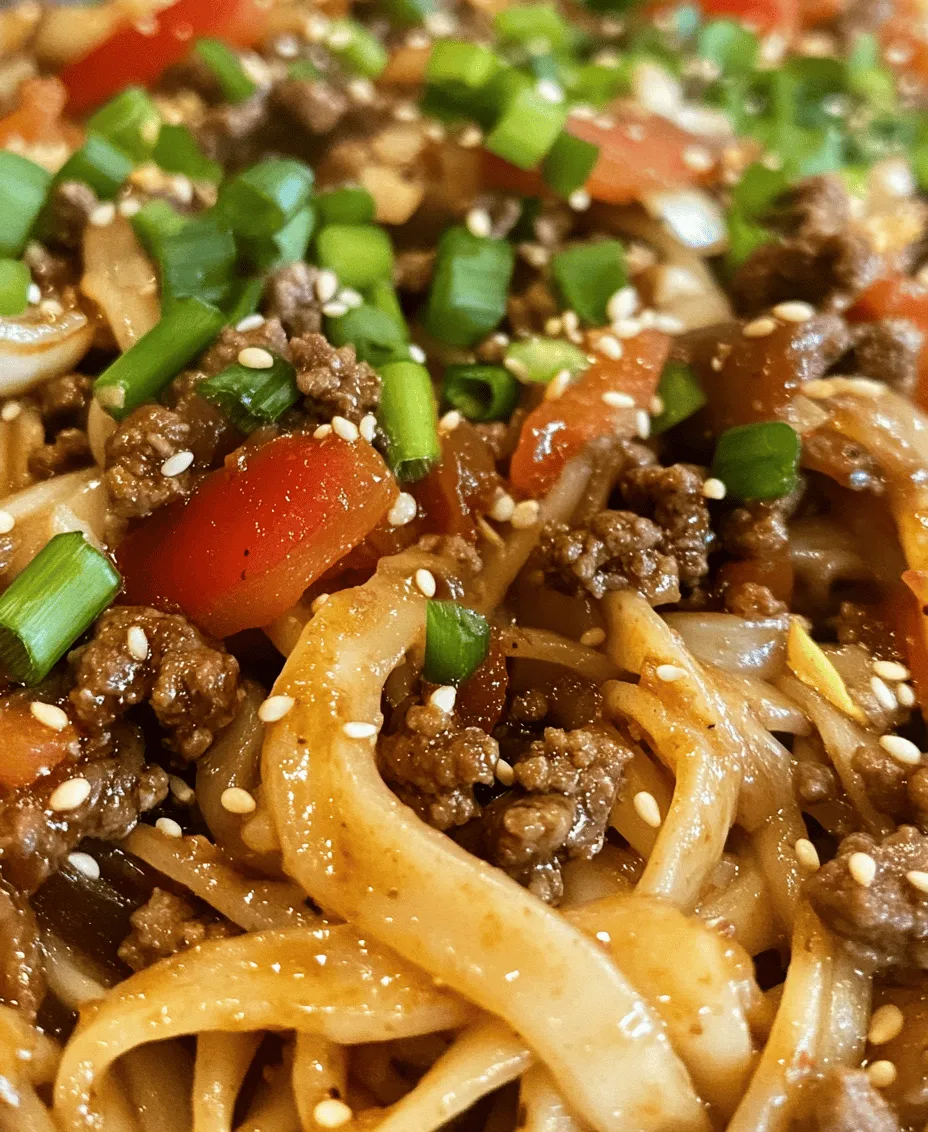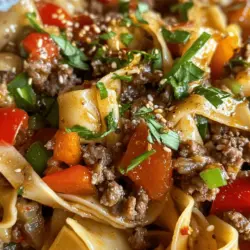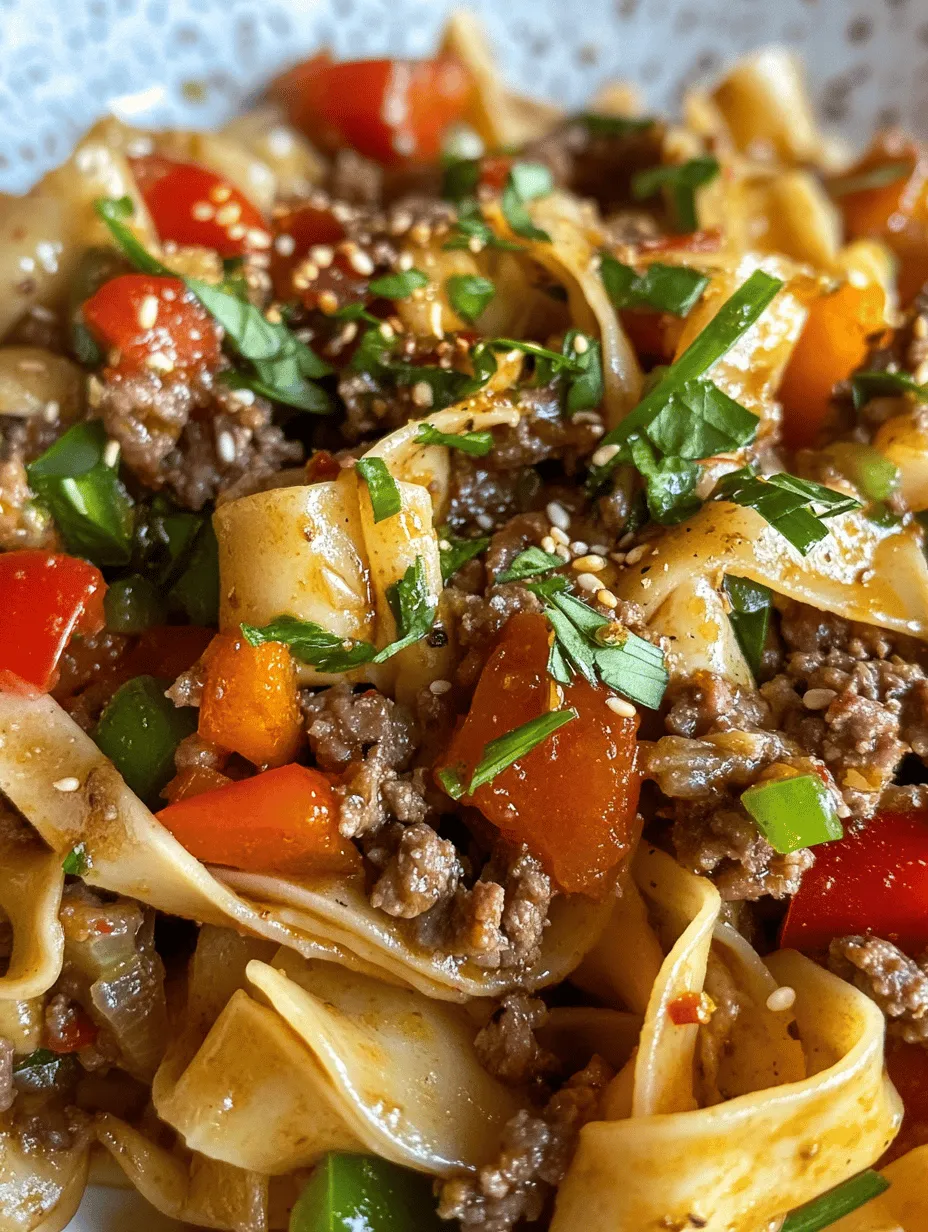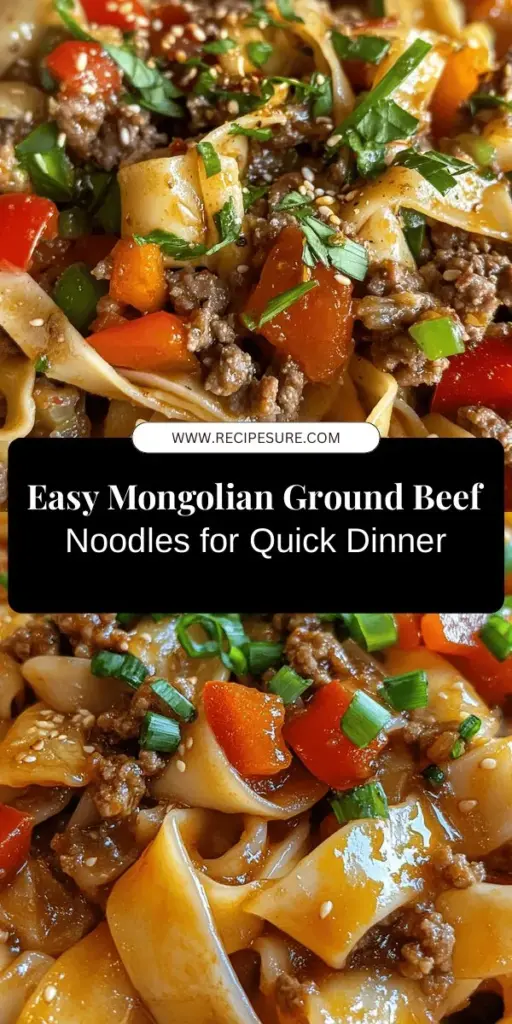Introduction
Mongolian cuisine, with its rich flavors and hearty ingredients, has captured the hearts (and stomachs) of food lovers around the world. Known for its emphasis on meat and dairy, Mongolian dishes often feature bold flavors and simple preparation techniques that make them both satisfying and accessible. One dish that perfectly embodies this culinary tradition is Mongolian Ground Beef Noodles. This delightful recipe combines tender ground beef, a medley of vibrant vegetables, and savory sauces, all tossed with noodles to create a quick and delicious meal.
In today’s fast-paced world, the demand for quick and easy dinner recipes has never been greater. Busy lifestyles often leave little time for elaborate cooking, making it essential to have a repertoire of meals that can be prepared in a snap. Mongolian Ground Beef Noodles is an ideal solution, as it can be whipped up in under 30 minutes, making it a perfect choice for those hectic weekdays or impromptu family gatherings.
This dish is a harmonious blend of flavors and textures. The savory depth of the beef, the satisfying chewiness of the noodles, and the crispness of the vegetables come together to create a culinary experience that is both indulgent and nourishing. Let’s delve into the key ingredients that make this dish so special and explore the step-by-step preparation of Mongolian Ground Beef Noodles.
Understanding the Key Ingredients
Ground Beef: Nutritional Benefits and Flavor Profile
At the heart of this recipe is ground beef, a versatile ingredient that not only brings robust flavor but also offers significant nutritional benefits. Ground beef is a good source of protein, essential for muscle repair and overall health. It also contains important vitamins and minerals, including Vitamin B12, iron, and zinc, which play crucial roles in energy production and immune function.
When selecting ground beef for this dish, it’s advisable to choose a blend with a moderate fat content, such as 80/20 or 85/15. This balance allows for a juicy and flavorful outcome while minimizing excess grease. Additionally, browning the beef properly enhances its flavor, creating a rich base for the sauce and noodles.
Wide Rice Noodles vs. Egg Noodles: Differences and Culinary Uses
The choice of noodles can significantly affect the dish’s final texture and mouthfeel. In this recipe, you can opt for either wide rice noodles or egg noodles, each offering unique characteristics.
Wide rice noodles, commonly used in various Asian cuisines, are gluten-free and have a chewy texture that absorbs sauces beautifully. They are often found in dishes like Pad See Ew or Pho, providing a satisfying bite.
On the other hand, egg noodles are made with wheat flour and eggs, offering a richer taste and a slightly firmer texture when cooked. They are prevalent in many Asian dishes as well, such as Chow Mein. Depending on your preference or dietary restrictions, either type of noodle can be used in this recipe, allowing for flexibility without compromising on taste.
Sauces: The Foundation of Flavor
The real magic in Mongolian Ground Beef Noodles comes from the combination of savory sauces that bring depth and complexity to the dish. Key sauces include soy sauce, oyster sauce, and hoisin sauce.
- Soy Sauce: This staple in Asian cooking provides a salty umami flavor that enhances the overall taste profile. It is essential for seasoning the meat and noodles.
- Oyster Sauce: Known for its rich and slightly sweet flavor, oyster sauce adds a layer of complexity. It is made from oyster extracts and thickened with cornstarch, making it a perfect pairing with beef.
- Hoisin Sauce: This sauce brings a sweet and tangy element to the dish, balancing the savory flavors of the other ingredients. It often contains garlic, vinegar, and sugar, making it a versatile addition.
Together, these sauces create a deliciously complex flavor that makes the dish irresistible.
The Role of Vegetables: Enhancing Flavor and Nutrition
The inclusion of vegetables is not only for added nutrition but also for enhancing the dish’s flavor and texture. Onions, bell peppers, garlic, and ginger are commonly used in Mongolian Ground Beef Noodles, each contributing its own unique taste profile.
- Onions: Sautéed until soft, onions add a sweet and savory base flavor that complements the beef beautifully.
- Bell Peppers: These add a vibrant color and a slight crunch. Their natural sweetness balances the dish’s savory elements.
- Garlic and Ginger: These aromatic ingredients infuse the dish with a warm, fragrant quality that elevates the overall flavor. Garlic provides a pungent base, while ginger adds a refreshing zest.
Incorporating these vegetables not only enhances the taste but also boosts the dish’s nutritional value, providing essential vitamins and minerals.
Importance of Garnishes: Elevating the Final Dish
Garnishes may seem like an afterthought, but they play a crucial role in elevating the final presentation and flavor of the dish. For Mongolian Ground Beef Noodles, green onions and optional red pepper flakes are common garnishes.
- Green Onions: These add a fresh, crisp element that contrasts with the richness of the beef and sauces. They also provide a pop of color, making the dish visually appealing.
- Red Pepper Flakes: For those who enjoy a bit of heat, sprinkling red pepper flakes can enhance the flavor profile and add a spicy kick.
By thoughtfully selecting and applying garnishes, you can transform a simple dish into a stunning centerpiece for your dinner table.
Step-by-Step Preparation of Mongolian Ground Beef Noodles
Now that we’ve explored the key ingredients, let’s dive into the step-by-step preparation of Mongolian Ground Beef Noodles. This comprehensive guide will ensure that your dish comes out perfectly every time, with detailed instructions on cooking the noodles, preparing the sauce, and combining all the elements for a delightful meal.
Cooking the Noodles: Tips for Achieving the Perfect Texture
1. Choose Your Noodles: Depending on your preference, select either wide rice noodles or egg noodles.
2. Boil Water: Fill a large pot with water and bring it to a rolling boil. This ensures that the noodles cook evenly.
3. Cook the Noodles: Add the noodles to the boiling water and cook according to package instructions. For rice noodles, this typically takes around 4-6 minutes, while egg noodles may require 6-8 minutes.
4. Check for Doneness: Taste a noodle to ensure it’s cooked to your desired level of doneness. They should be tender but still have a slight bite, known as ‘al dente’.
5. Drain and Rinse: Once cooked, drain the noodles in a colander and rinse them under cold water. This stops the cooking process and prevents them from sticking together.
6. Toss with Oil: Drizzle a little sesame oil or vegetable oil over the noodles and toss gently. This step helps to keep the noodles separate and adds a subtle flavor.
Sauce Preparation: Balancing Flavors for Optimal Taste
1. Combine the Sauces: In a small bowl, whisk together soy sauce, oyster sauce, and hoisin sauce. Adjust the quantities to suit your taste preferences, keeping in mind that the balance of savory, sweet, and umami is key.
2. Add Water: To thin the sauce slightly and help it coat the noodles better, add a tablespoon or two of water. This also helps to prevent the dish from becoming too salty.
3. Set Aside: Once combined, set the sauce aside. It will be added later when the beef and vegetables are cooked.
Cooking the Ground Beef: Techniques for Browning and Draining Excess Fat
1. Heat the Pan: In a large skillet or wok, heat a tablespoon of oil over medium-high heat.
2. Add the Beef: Once the oil is hot, add the ground beef to the pan. Break it apart with a wooden spoon or spatula.
3. Brown the Beef: Cook the beef until it is browned and no longer pink, about 5-7 minutes. Make sure to stir occasionally for even cooking.
4. Drain Excess Fat: If there’s an excess of fat in the pan, carefully drain it off to avoid a greasy dish. This step will enhance the overall flavor and texture of the noodles.
5. Season the Beef: Once browned, season the beef lightly with salt and pepper to elevate its flavor.
Sautéing the Vegetables: Ensuring the Right Texture and Flavor Infusion
1. Add Aromatics First: To the same skillet with the beef, add minced garlic and grated ginger. Sauté for about 30 seconds until fragrant, being careful not to burn them.
2. Incorporate Vegetables: Add sliced onions and bell peppers to the pan. Stir-fry for 2-3 minutes until the onions become translucent and the bell peppers are slightly tender.
3. Maintain Crunch: The goal here is to retain a bit of crunch in the vegetables, so avoid overcooking them. They should be bright and colorful, adding both flavor and visual appeal to the dish.
Combining Ingredients: Strategies for Even Distribution of Sauce and Flavors
1. Add the Noodles: Once the vegetables are cooked, add the prepared noodles to the skillet.
2. Pour in the Sauce: Drizzle the sauce over the noodles and toss everything together gently. Use tongs or a spatula to ensure that the noodles and beef are evenly coated with the sauce.
3. Stir-Fry Together: Continue to stir-fry the mixture for an additional 2-3 minutes on medium heat. This allows the flavors to meld together and ensures that the noodles are heated through.
4. Taste and Adjust: Before serving, taste the dish and adjust the seasoning if necessary. You can add more soy sauce for saltiness or a touch of sugar for sweetness, depending on your preference.
This step-by-step guide will help you create a stunning plate of Mongolian Ground Beef Noodles that is not only quick to prepare but also bursting with flavor. Whether you are looking for an easy weeknight dinner or a dish to impress guests, this recipe is sure to become a favorite in your culinary repertoire.
Stay tuned for the next part, where we will share tips for achieving the best results and answer some common questions about this delightful dish.

Final Touches: The Importance of Sesame Oil and Seasoning Adjustments
Adding the final touches to your Mongolian Ground Beef Noodles elevates the dish from good to unforgettable. One key ingredient that should not be overlooked is sesame oil. This fragrant oil is a staple in Asian cuisine and brings a nutty flavor that harmonizes beautifully with the savory beef and the umami-rich sauce. To finish off your dish, drizzle a teaspoon or two of toasted sesame oil over the noodles just before serving. This not only enhances flavor but also adds a lovely sheen that makes the dish appear more appetizing.
When it comes to seasoning, it’s important to adjust according to your taste preferences. After mixing the ground beef with the noodles and sauce, take a moment to taste the dish. If it feels a bit flat, consider adding a splash more soy sauce or a pinch of salt. Alternatively, if you enjoy a touch of sweetness, a bit more brown sugar can help balance the flavors. Remember that the beauty of home cooking lies in personalization, so feel free to make adjustments that suit your palate best.
Nutritional Analysis of Mongolian Ground Beef Noodles
Understanding the nutritional profile of your meal can help you make informed dietary choices. A typical serving of Mongolian Ground Beef Noodles contains approximately:
- Calories: 450-500 kcal
- Protein: 30-35 grams
- Carbohydrates: 50-60 grams
- Fats: 15-20 grams
This dish is rich in protein from the ground beef, making it a great option for those looking to build or maintain muscle. The carbohydrates from the noodles provide essential energy, while the fats—especially when using sesame oil—contribute healthy fats that are beneficial for heart health.
Health Benefits of Main Ingredients
1. Ground Beef: A great source of protein, iron, and B vitamins, ground beef supports muscle maintenance, energy production, and overall health.
2. Noodles: Depending on the type of noodles you choose, they can provide complex carbohydrates that are essential for energy. Whole grain or whole wheat noodles could increase fiber intake.
3. Vegetables: If you add veggies like bell peppers, broccoli, or snap peas, you’ll boost the dish’s vitamin and mineral content, contributing to a balanced diet.
Potential Allergens and Dietary Considerations
When preparing Mongolian Ground Beef Noodles, it’s essential to consider potential allergens. The primary allergens in this dish may include soy (from soy sauce), wheat (if using traditional noodles), and sesame (if using sesame oil).
For those with gluten sensitivities or celiac disease, gluten-free noodles made from rice or quinoa can be excellent alternatives. Additionally, for vegetarians or vegans, substituting ground beef with tofu or tempeh not only makes the dish plant-based but also introduces a unique texture that pairs well with the other ingredients.
Variations and Customizations
One of the best aspects of the Mongolian Ground Beef Noodles recipe is its versatility. Here are some ideas for customization:
Protein Substitutions: If you’re looking to switch up the protein, consider using diced chicken breast, shrimp, or plant-based proteins such as tofu or tempeh. Each option will bring its own unique flavor and texture to the dish while maintaining the core elements of this beloved recipe.
Exploring Vegetable Variety: To enhance both the nutritional value and appearance of your meal, feel free to add a variety of vegetables. Broccoli florets, julienned carrots, and snap peas not only add color but also contribute additional vitamins and minerals.
Modifying Sauce Ingredients: If sodium is a concern, consider using low-sodium soy sauce or tamari. For those watching their sugar intake, coconut sugar or a sugar substitute can be used without sacrificing flavor.
Spicing It Up: If you enjoy a bit of heat, there are several ways to incorporate spice into your dish. Sriracha, chili garlic sauce, or even fresh ginger can provide a delightful kick that complements the savory notes of the beef and noodles.
Serving Suggestions and Pairings
To create a well-rounded meal, consider complementing your Mongolian Ground Beef Noodles with various side dishes and beverages.
Side Dishes: Steamed vegetables such as bok choy or a simple side salad with sesame dressing can add freshness and balance to your meal. Spring rolls filled with vegetables or shrimp can also serve as a delightful appetizer.
Beverage Pairings: For a complete dining experience, consider pairing your noodles with beverages that enhance the flavors of your meal. Light, refreshing drinks like iced green tea or a crisp lager can cut through the richness of the dish. For a non-alcoholic option, a sparkling water with a wedge of lime can be quite refreshing.
Presentation Tips: The way you plate your Mongolian Ground Beef Noodles can significantly influence the dining experience. Serve the noodles in a shallow bowl, twisting them artfully into a mound. Garnish with chopped green onions, sesame seeds, and perhaps a sprinkle of fresh cilantro for a pop of color. A lime wedge on the side not only adds visual appeal but allows diners to add a touch of acidity to brighten the dish.
Conclusion
In summary, the Mongolian Ground Beef Noodles recipe is a quick, simple, and utterly delicious option for dinner. Its savory flavors, combined with the delightful texture of the noodles, make it a favorite for many. The ability to customize the dish to suit your taste—whether through choosing different proteins, adding vibrant vegetables, or adjusting the sauce—ensures that it can be enjoyed time and again without growing stale.
We encourage you to try this recipe for yourself, experimenting with your variations to find your perfect blend of flavors. Cooking is not just about sustenance; it’s about creativity and the joy of sharing meals with loved ones. As you gather around the table enjoying your Mongolian Ground Beef Noodles, remember that the heart of this dish lies in the love and effort you put into preparing it. Happy cooking!


